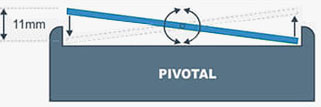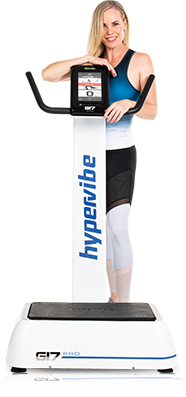
In Pivotal vibration machines, the platform you stand on tilts around a central pivot point like a see-saw. The left and right sides alternate up and down while the centre remains fixed.
You can change the total distance your feet move up and down (other terms include ‘displacement’and ‘peak-to-peak amplitude’) by moving them either closer or further away from the centre. The maximum possible distance varies from one machine to another but most are generally close to 10mm.
Advantages of Pivotal platforms
- The movement mimics the natural rotation of the hips during walking and running which may activate a greater range of muscles and reduce vibration that occurs in the head.
- The side to side alternating movement allows greater transmission of vibration energy at higher amplitudes. In other words – it generates more muscle stimulation when compared to a Lineal platform operating at the same frequency.
Disadvantages of Pivotal platforms
- During upper body exercises it is generally more comfortable for the hands if they are placed close together near the centre of the platform where the amount of movement is minimal, particularly when higher frequencies are being used. With a Lineal platform, hand position is less restricted as the amount of movement is the same at every point on the platform surface.
- At highest amplitudes, lightweight people may find that their feet can slide or skid around on the platform, particularly if the frequency is very high. If your feet are sliding around the vibration is not being adequately transferred to your muscles and bones and therefore you should reduce the frequency or amplitude to a point where your feet do not skid..






